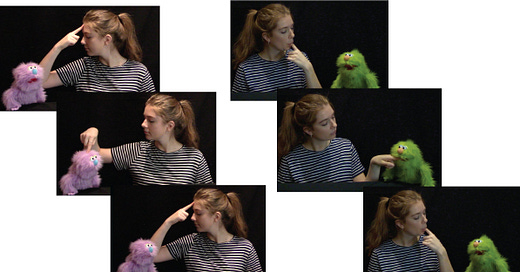Babies know that we only share spit with people we care about
Saliva transfer is everyone's love language
My son giggles whenever I use my mouth to take food from his hands (or when our dog does it), or when I pretend to “eat” him by nibbling his hand or nuzzling his belly. I’m that parent who, in a pinch, will lick her hand in order to clean her son’s face. He has also started a habit that makes me angrier than probably anything else he has ever done: Sometimes when I feed him pureed food, he will blow raspberries, spitting food all over himself (and me). It’s innocuous - intellectually, I know it’s just a new, fun sensation for him. However, feeding someone is inherently intimate, and my anger likely stems from the immediate reaction that he is somehow showing ingratitude towards this gesture.
Sharing food, kissing, other intimate acts where saliva is transferred from one person to another… we only do this with people we feel connected to. You probably haven’t thought about spit specifically being a sign of affection, but it is. Other animals do it (think about dogs licking each other) and it’s likely evolutionarily advantageous (think of, well, who you want to share spit with during the pandemic).
Thomas and colleagues just published a paper in Science (accessible version here, Twitter summary by the first author here) all about how even young babies understand that you only share spit with people you care about. While this study isn’t explicitly about mental health per se, I generally think anything that advances our understanding of social/emotional behavior is integral to better understanding mental health. Also, it’s just a really cool study!
So, how do researchers figure out what a non-speaking, non-pointing miniature human understands? Infant behavioral science is built around the notion that babies look at some things more than other things. My son looks at me for a longer period of time than someone he doesn’t know very well, just like he watches me eat more intently when he’s hungry than when he’s not. Researchers know that something is interesting or important to a baby if it looks at it for a longer span of time than something else.
In multiple studies, Thomas and colleagues found that babies’ behaviors indicated that they understood that sharing spit was a more intimate act than sharing a toy or touching someone else. I particularly liked the puppet studies. In one, they showed babies and toddlers (ages ~8.5-19 months) videos of different actors interacting with one puppet. One actor shared food with the puppet, while the other actor shared a toy ball with the same puppet. Then, the children watched a video of the puppet “in distress” with both actors present. The children looked at the actor who had shared food with the puppet first and for a longer duration than the other actor, suggesting that the babies expected that the actor who shared food with the puppet would be the one to comfort it. They found the same results when they tested a separate group of toddlers (14.5-19 months). Additionally, the toddlers watched a video of the puppet requesting the ball. In this case, toddlers looked first and longer at the ball-passing actor than the food-sharing one.
In a separate study, they did something similar: The same actor literally shared her spit with one puppet, but only did a forehead-to-forehead touch with a different puppet (see photo below). Then, the actor looked distressed in front of both puppets. Infants and toddlers looked longer at the puppet that the actor shared spit with than the puppet that the actor only touched (only toddlers looked at the spit-sharer first). So not only do babies understand that spit-sharers can be caregivers (like in the first studies), but they also understand that we care for those who share their spit with us.
It’s so interesting to me that even young babies can understand something pretty subtle about how we interact with each other. Now, I like to think that my son giggles when I try to “eat” him or take his food not only because it’s silly, but also because he senses that we are connected and that we care for one another. He’s learning that this is just one of many ways to show someone that they matter.





